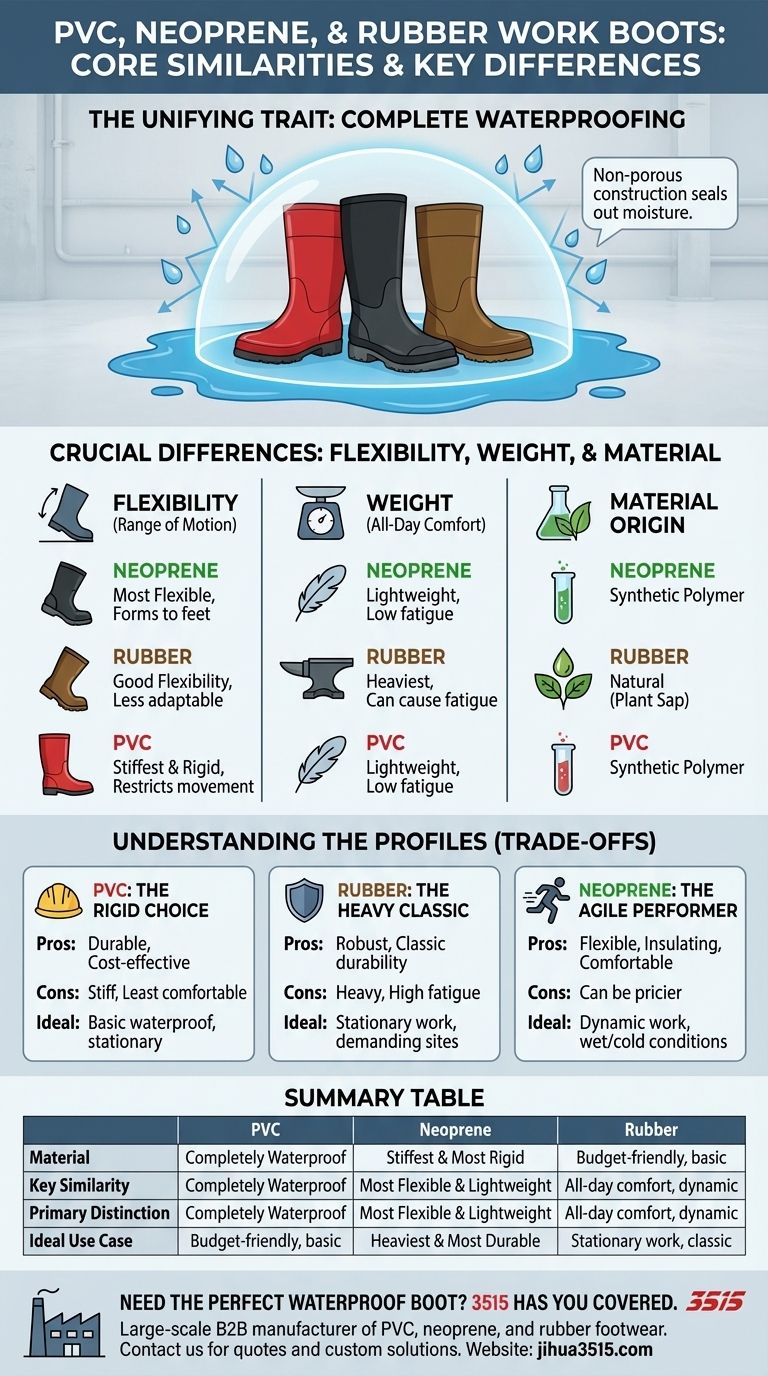At their core, the main similarity between PVC, neoprene, and rubber work boots is their completely waterproof construction. All three materials are non-porous, effectively sealing out liquids and preventing moisture absorption, which makes them the primary choices for any job that involves standing water or consistently wet conditions.
While all three materials provide excellent waterproofing, this shared trait is where their similarities end. The crucial differences in flexibility, weight, and material composition are what will ultimately determine the right boot for your specific work environment.

The Unifying Trait: Complete Waterproofing
The fundamental reason these three materials are grouped together is their shared ability to create an impenetrable barrier against moisture. Unlike leather or fabric, they do not rely on a treated membrane; their very structure is waterproof.
How They Seal Out Moisture
Both PVC (a plastic polymer) and neoprene (a synthetic rubber) are man-made materials designed to be impervious to liquids. Natural rubber, once vulcanized, also becomes a non-porous material that water cannot penetrate.
Ideal Use Case: Wet Environments
This shared quality makes all three boot types suitable for wading, power washing, and working in mud, slush, or rain. Taller boot designs made from these materials further ensure that moisture cannot enter from the top, providing comprehensive protection.
Why Differentiating Them is Crucial
Beyond their shared waterproof nature, these materials diverge significantly. Understanding their unique properties is key to selecting a boot that provides not just protection, but also comfort and performance for your specific tasks.
Material Origins: Natural vs. Synthetic
A key distinction is the source of the material. Rubber is a natural product derived from the sap of plants. In contrast, PVC and neoprene are synthetic polymers created through industrial processes.
Flexibility and Range of Motion
Flexibility directly impacts comfort and mobility. Neoprene is by far the most flexible, easily molding to the shape of your feet and calves for a personalized, restriction-free fit.
Rubber offers good flexibility, but it is generally less adaptable than neoprene. PVC is the stiffest and most rigid of the three, offering less give and potentially restricting ankle and foot movement.
Weight and All-Day Comfort
The weight of your boots can be a major factor in end-of-day fatigue. PVC and neoprene boots are both known for being lightweight, making them comfortable for long periods of standing or walking.
Rubber boots, especially those with thicker, heavy-duty construction, tend to be significantly heavier. This added weight can lead to discomfort and fatigue over a full workday.
Understanding the Trade-offs
Each material comes with a distinct set of advantages and disadvantages. Choosing the right one means aligning its profile with the demands of your job.
The Rigidity of PVC
PVC's stiffness can be a drawback for jobs requiring agility, but it also provides a rigid structure. It is a highly durable and often cost-effective option for basic waterproof protection where flexibility is not a priority.
The Weight of Rubber
The substantial feel of a thick rubber boot offers a classic sense of durability. However, this inherent weight is a significant trade-off and can be a source of strain for workers who cover a lot of ground.
The Balanced Profile of Neoprene
Neoprene stands out as an excellent all-around performer. It is not only waterproof and flexible but also self-insulating, shock-absorbing, and exceptionally comfortable, making it a premium choice for dynamic work in wet or cold conditions.
Making the Right Choice for Your Job
To select the best boot, match the material's strengths to your primary need.
- If your primary focus is all-day comfort and mobility: Choose neoprene for its superior flexibility, light weight, and form-fitting comfort.
- If your primary focus is traditional durability for stationary work: Classic rubber boots provide robust protection, though at the cost of higher weight.
- If your primary focus is a budget-friendly, basic waterproof solution: PVC offers effective water protection but is the most rigid and least comfortable option.
Ultimately, looking past their shared waterproof quality to their core differences will guide you to the perfect boot for your needs.
Summary Table:
| Material | Key Similarity | Primary Distinction | Ideal Use Case |
|---|---|---|---|
| PVC | Completely Waterproof | Stiffest & Most Rigid | Budget-friendly, basic waterproofing |
| Neoprene | Completely Waterproof | Most Flexible & Lightweight | All-day comfort, dynamic work |
| Rubber | Completely Waterproof | Heaviest & Most Durable | Stationary work, classic protection |
Need the Perfect Waterproof Work Boot for Your Team?
As a large-scale manufacturer, 3515 produces a comprehensive range of PVC, neoprene, and rubber footwear for distributors, brand owners, and bulk clients. Our production capabilities encompass all types of waterproof shoes and boots, ensuring you get the right combination of protection, comfort, and durability for your specific needs.
Let us help you equip your workforce with high-quality, reliable footwear. Contact our experts today to discuss your requirements and get a quote!
Visual Guide

Related Products
- High Performance Fire-Retardant Waterproof Safety Boots
- Factory-Direct Wholesale Canvas Boots with High-Traction Rubber Soles
- Factory Direct Wholesale Rain Boots Durable Waterproof & Fully Customizable
- Wholesale Waterproof Tactical Boots Custom Suede & High-Traction Soles
- Premium High-Cut Waterproof Safety Boots Manufacturing & Wholesale Solutions
People Also Ask
- What standards are used to test and rate safety-toe footwear? Ensure Your Boots Are Truly Protective
- What are the different types of materials used in the toe portion of safety toe work boots? A Guide to Steel, Alloy & Composite
- How should one choose between steel toe and composite toe shoes? Match Your Work Hazards for Optimal Safety
- How can comfort be improved when wearing steel toe boots? A Guide to Pain-Free Workdays
- How does the weight of steel-toe boots compare to composite-toe boots? Uncover the Real Trade-Offs



















